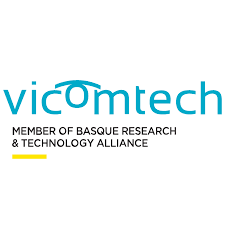Type:
Country:
Contact:
Telephone:
Website:
R&D center
Spain
Oihana Otaegui
http://www.vicomtech.org/en

Expertise
The role of Vicomtech in the market is to supply society with technology by transfer of primary research to industry. This is done through collaborative R&D projects. Vicomtech’s main research lines lay in the fields of computer vision, computer graphics and interaction, technologies which the centre applies across multiple sectors. Vicomtech is a non-profit applied research centre for Interactive Computer Graphics, Artificial Intelligence and Multimedia founded in 2001 as a joint venture between the Fraunhofer INI - GraphicsNet Foundation and the EiTB Broadcasting Group. More than 100 of its 145 employees are researchers of which 50+ hold doctoral degrees. Vicomtech includes a department dedicated to Intelligent Transport Systems and Engineering with over 30 researchers. The team applies HPC, Cloud Computing, Big Data, AI and Computer Vision to the industrial sector in general and the transport sector in particular, providing companies with advanced technology solutions.
Participation in EU Projects and International Activities
Vicomtech actively participates in European projects, some initiatives of note are listed below:
As coordinator:
CLOUD-LSVA - Cloud Large Scale Video Analysis (H2020, ICT-16-2015 - Big data – research): Semi-automated annotation that leverages the elasticity of Cloud computing in order to reduce the cost of the task for a sustainable basis to drive forward automotive Big Data Technologies. VI-DAS - Vision Inspired Driver Assistance Systems (H2020, MG-3.6a-2015 - Safe and connected automation in road transport): VI-DAS advances in computer vision and machine learning will introduce non-invasive, vision-based sensing capabilities to vehicles and enable contextual driver behaviour modelling. INLANE – Low Cost GNSS and Computer Vision Fusion for Accurate Lane Level Navigation and Enhanced Automatic Map Generation (H2020, GALILEO-1-2015 - EGNSS applications): New generation, low-cost, lane-level, precise turn-by-turn navigation applications through the fusion of EGNSS and Computer Vision technology. 5GMETA – Monetizing car & mobility data for new Entrants, Technologies and Actors (H2020, ICT-42-2020 - 5G PPP – 5G core technologies innovation): Aims to leverage car-captured data to stimulate, facilitate and feed with them innovative products and services. The result of 5GMETA will empower the automotive ecosystem from industry players to new entrants, such as SMEs and high-tech start-ups granting access to interoperable car-captured data according to data licenses. ACCURATE - Towards the development and validation of Enhanced Multi-sensor and EGNSS Multifrequency tight fusion for leveraging high levels of automated driving L4/L5 (H2020, SPACE-EGNSS-2019): GSA Fundamental Elements project focused on the development of an a high precision positioning On Board Unit (OBU), that can be integrated in systems required by any vehicle OEM, based on a tight heterogenous sensor fusion that will be easily integrated in Automated Driving platforms in order to reach SAE L4 and L5 automated driving levels. As partner:
5G MOBIX - 5G for cooperative & connected automated MOBIility on X-border corridors (H2020, ICT-18-2018 - 5G for cooperative, connected and automated mobility (CCAM)): CCAM trials along x-border and urban corridors using 5G core technological innovations to qualify the 5G infrastructure and evaluate its benefits in the CCAM context as well as defining deployment scenarios and identifying and responding to standardisation and spectrum gaps. AUTOPILOT - AUTOmated driving Progressed by Internet of Things (H2020, IoT-01-2016 - Large Scale Pilots): AUTOPILOT brings IoT into the automotive world to transform connected vehicles into highly and fully automated vehicle. TRANSSEC - Autonomous emergency manoeuvring and movement monitoring for road transport security (H2020, GALILEO-1-2017 - EGNSS Transport applications): Development and evaluation of systems built-in or to be used by trucks for secure road transport of (dangerous) goods, preventing trucks and transport of goods to be misused for other purposes such as terror attacks. HEADSTART - Harmonised European solutions for testing automated road transport (H2020, DT-ART-01-2018): define testing and validation procedures of Connected and Automated Driving (CAD) functions including its key enabling technologies (i.e. communications, cyber-security, positioning) by cross-linking of all test instances such as simulation, proving ground and real world field tests to validate safety and security performance according to the needs of key user groups (technology developers, consumer testing groups and type approval authorities). 5D AEROSAFE - 5 services of Drones for increased airports and waterways safety and security (H2020, MG-2-8-2019 - Innovative applications of drones for ensuring safety in transport): Develop a set of drone-based services and solutions to increase the safety and security of airports and waterways. It will also focus on ways of reducing operational costs through the offering of the following services: CNS/GNSS equipment inspection and calibration, security checks at the airport perimeter and approaches as well as runway, taxiway, aircraft and waterway inspections. CPS4EU - Cyber Physical Systems for Europe (H2020, ECSEL-2018-1-IA - ECSEL-2018-1-IA): Advances in CPS are resulting in systems that respond quicker and with more precision with a relevant impact in smart grid and autonomous automobile systems, medical monitoring and robotics systems. 5G LOGINNOV- 5G creating opportunities for LOGistics supply chain INNOVation (H2020, ICT-42-2020 - 5G PPP – 5G core technologies innovation). 5G-LOGINNOV project will design an innovative scheme to integrate and validate CAD/CAM technologies related to the industry 4.0 and port domains, by creating new opportunities for logistics value chain innovation. The innovation is supported by 5G technological blocks, including a new generation of 5G terminals, new types of Internet of Things 5G instruments, data analytics, next-generation traffic management and emerging 5G networks allowing ports to manage upcoming and future capacity, traffic, efficiency and environmental challenges.
